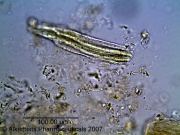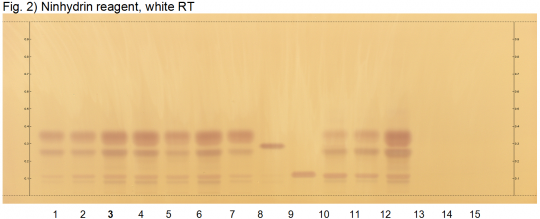Isatis tinctoria (root)
(addition of hptlc info.--jd) |
m |
||
| Line 51: | Line 51: | ||
| }} | | }} | ||
| − | |||
| − | |||
| − | |||
| − | |||
| − | |||
| − | |||
| − | |||
| − | |||
| − | |||
| − | |||
| − | |||
| − | |||
| − | |||
| − | |||
| − | |||
| − | |||
| − | |||
| − | |||
| − | |||
| − | |||
| − | |||
| − | |||
| − | |||
| − | |||
| − | |||
| − | |||
| − | |||
| − | |||
| − | |||
| − | |||
| − | |||
| − | |||
| − | |||
| − | |||
| − | |||
| − | |||
| − | |||
| − | |||
| − | |||
| − | |||
| − | |||
| − | |||
| − | |||
=Other Points of Interest= | =Other Points of Interest= | ||
[[Category:NoIntro]] | [[Category:NoIntro]] | ||
Revision as of 18:37, 21 June 2013
Contents |
Introduction
Macroscopic Entries
Microscopic Entries
|
HPTLC Entries
|
Isatis (root) (Isatis tinctoria) Lane Assignments Lanes, from left to right (Track, Volume, Sample):
Reference Sample(s) Reference: Dissolve 4 mg of L-arginine monohydrochloride in 1 mL of ethanol 70%. Dissolve 4 mg of L-cysteine hydrochloride monohydrate in 1 mL of ethanol 70%. Stationary Phase Stationary phase, i.e. Silica gel 60, F254 Mobile Phase Acetonitrile, water, formic acid 30:8:2 (v/v/v) Sample Preparation Method Sample: Mix 500 mg of powdered sample with 5 mL of ethanol 70% and sonicate for 10 min, then centrifuge or filter the solutions and use the supernatants / filtrates as test solutions. Derivatization reagent: Before derivatization, treat plate with ammonia 25% vapor for 5 min.; Ninyhdrin reagent; Preparation: Dissolve 0.6 g of ninhydrin in 190 mL of isopropyl alcohol (2-propanol) and add 10 mL of glacial acetic acid; Use: Dip (time 0, speed 5), heat at 120°C for 3 min. Detection Method Saturated chamber; developing distance 70 mm from lower edge; relative humidity 33% Other Notes Images presented in this entry are examples and are not intended to be used as basis for setting specifications for quality control purposes. System suitability test: L-Cysteine hydrochloride monohydrate: a brown zone at Rf ~ 0.29; L-Arginine monohydrochloride: a brown zone at Rf ~ 0.12. Identification: Compare result with reference images. The fingerprint of the test solution is similar to that of the corresponding botanical reference sample. Additional weak zones may be present. The chromatogram of the test solution shows a brown zone (Rf ~ 0.12) at the position of reference arginine. Right below it there is another faint brown zone. There is a brown zone at Rf ~ 0.25 right below the zone due to reference substance cysteine. Just above cysteine there is a prominent brown zone at Rf ~ 0.34.
|
Other Points of Interest
Cite error: <ref> tags exist, but no <references/> tag was found


